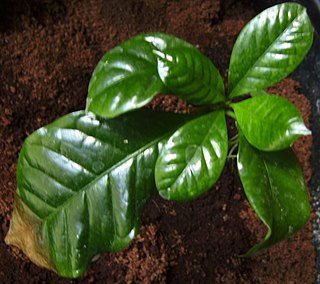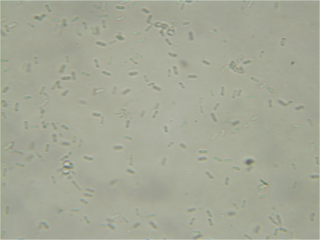
Phoma costaricensis is a plant pathogen infecting coffee. It is a soil fungus that infects the leaves and fruits of the coffee plant prior to the fruit ripening.
Phyllosticta capitalensis is a cosmopolitan fungal plant pathogen that grows on many hosts either as an endophyte or as a saprobe on dead tissue, including species of Citrus and Musa (bananas). There are some reports of it infecting orchids, such as cattleyas or Cymbidium.
Pleosphaerulina sojicola is a plant pathogen commonly causing spotted decolouration on the leafs of soybeans.
Stagonosporopsis trachelii is a fungal plant pathogen that causes Ascochyta leaf spot in Campanula species.
Coniothyrium glycines is a fungal plant pathogen infecting soybean.
Phoma microspora is a fungal plant pathogen known for infecting peanuts.
Phoma nebulosa is a fungal plant pathogen infecting spinach.
Didymella pinodella is a fungal plant pathogen infecting pea and red clover.
Phoma strasseri is a fungal plant pathogen infecting mint.
Phoma tracheiphila is a fungal plant pathogen. It causes a disease known as Mal secco on citrus trees. It occurs in dry, cool climates such as the Mediterranean, Black Sea and Asia Minor. It forms pycniospores that are carried short distances by rain, or by wind to new leaves, where germinated hyphae invade stomata or more likely fresh wounds.

Phoma destructiva is a fungal plant pathogen infecting tomatoes and potatoes.

Phoma is a genus of common coelomycetous soil fungi. It contains many plant pathogenic species.
Calophoma clematidina is a fungal plant pathogen and the most common cause of the disease clematis wilt affecting large-flowered varieties of Clematis. Symptoms of infection include leaf spotting, wilting of leaves, stems or the whole plant and internal blackening of the stem, often at soil level. Infected plants growing in containers may also develop root rot.
Stagonosporopsis is a genus of ascomycote fungi, containing several pathogens to plants.
Hubertus Antonius van der Aa was a Dutch mycologist who described several genera and species of fungi. He studied at Utrecht University where he received his PhD in 1973 with the dissertation Studies in phyllosticta I.

The Didymellaceae are a family of fungi in the order Pleosporales. They have a world-wide distribution.

Peyronellaea is a genus of fungi in the family Didymellaceae. It contains a number of plant pathogens.
Peyronellaea curtisii is a fungal plant pathogen first described by Miles Joseph Berkeley and received its current name in 2010. Formerly it was Stagonosporacurtisii. It is a cause of leaf blotch, and its substrates include Narcissus, Galanthus and Hippeastrum.
Phoma wilt is a disease of the common hop plant caused by several species of fungal plant pathogens in the genus Phoma. These include Phoma herbarum and Phoma exigua, and possibly other as yet unidentified species. Phoma infection may cause decreased yields, but Phoma wilt is not considered to be a very common or destructive disease of the hop plant.

Boeremia exigua is the type species of the fungus genus, Boeremia, in the Didymellaceae family. It was first described as Phoma exigua by John Baptiste Henri Joseph Desmazières in 1849, and transferred to the genus, Boeremia, by M.M. Aveskamp, J. de Gruyter, J.H.C. Woudenberg, G.J.M. Verkley and P.W. Crous in 2010.




